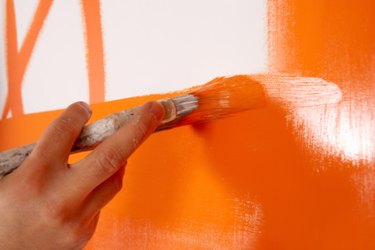
The five basic elements of design are what make up paintings, drawings and other types of art. Each element adds something different to a work of art and can change the overall mood or feel of artwork. The elements of design are used in many industries by artists, architects, interior designers and graphic designers.
Line
Video of the Day
Line is an element of art that contours, outlines or defines a shape. Lines can be thick or thin, loose, sharp, curvy or straight. A line can simply be a mark that goes from one point to another, or it can be used to outline a form. According to Princeton University's Incredible Art Department website, lines have many characteristics. They can be horizontal, vertical, diagonal, blurry or choppy. Lines can also take on a mood. A graceful line may create a calm feeling, while jagged, sharp lines may create an angry mood in artwork.
Video of the Day
Shape
According to the Incredible Art Department website, shape is when a line crosses itself or intersects with other lines to create an enclosed space. Shapes can be geometric, such as circles, squares, rectangles or triangles. Shapes can also be those seen in nature, such as flowers, leaves or seashells. Static shapes appear to be stable and still, while dynamic shapes appear to be moving. Positive shapes are solid forms in artwork, such as a bowl of fruit, while a negative shape is the space surrounding a positive shape.
Texture
Texture is the surface quality of an object in a piece of art. According to the Incredible Art Department website, real texture is an object's actual texture, such as a rough or jagged rock. Real textures play a vital role in architecture, interior design and sculpture. Implied texture is used in painting or drawing to make an object appear rough or smooth, even though it is two-dimensional.
Color
Color is used to add interest to an art object. There are four categories or color: primary, secondary, intermediate and complementary. These breakdowns of color are represented on a color wheel, an important tool for an artist. Primary colors are red, yellow and blue, and cannot be created from other colors. Secondary colors are orange, violet and green, and are created by mixing two primary colors. Intermediate colors, also called tertiary colors, include red orange, yellow green, and blue violet, and come from mixing a primary color and a secondary color. Complementary colors are opposite from each other on the color wheel, and tend to make each other look brighter when used together. An example of complementary colors is blue and orange.
Mass or Size
The mass or size of an object is the fifth basic element of design. This refers to the amount of space a two- or three-dimensional object takes up. An object's mass in relation to other objects in the picture plane affects the proportion or scale of work of art. As an example, a picture of a person can take on a whole different scale if a tall tree is also placed in the picture.